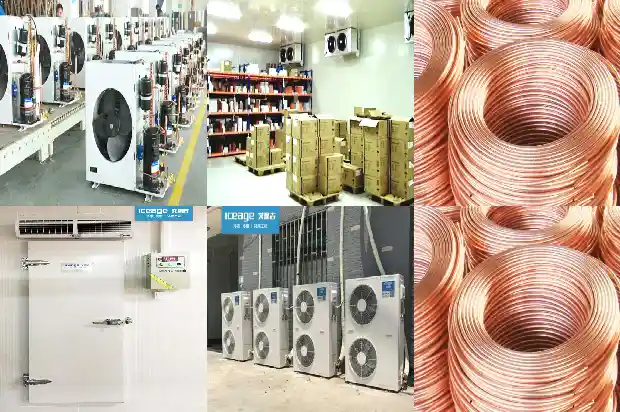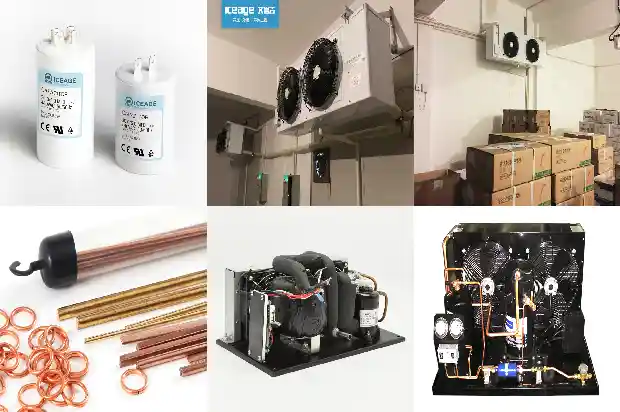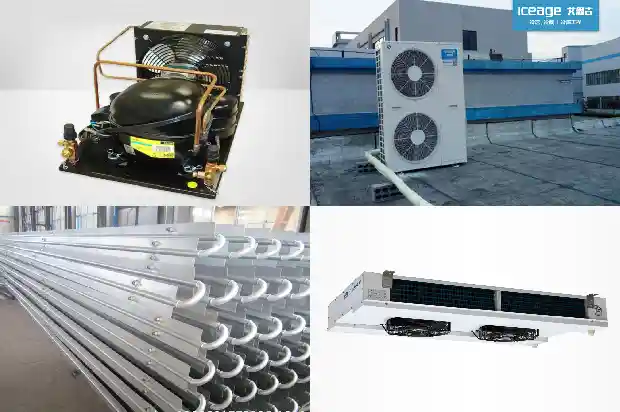Analysis of the Causes of Frost Formation at the Suction Port of the Refrigeration Compressor
2025-03-12
I. Frost Formation at the Suction Port of the Compressor
Frost formation at the suction port of the compressor indicates that the temperature of the return gas of the compressor is too low. So, what situations can lead to such a low temperature of the return gas of the compressor?
It is known that for the refrigerant of the same mass, if the volume and pressure are changed, the temperature will show different performances. That is, if the liquid refrigerant absorbs more heat, then the refrigerant of the same mass will show higher values in terms of pressure, temperature, and volume. If it absorbs less heat, then the pressure, temperature, and volume will all be low.
In other words, if the return gas temperature of the compressor is low, it will generally be accompanied by a low return gas pressure and a high amount of refrigerant in the same volume. The root cause of this situation is that the refrigerant flowing through the evaporator cannot fully absorb the heat required for it to expand to the predetermined pressure and temperature values, resulting in relatively low values of temperature, pressure, and volume of the return gas.
There are two reasons leading to this problem:
Frost formation at the suction port of the compressor indicates that the temperature of the return gas of the compressor is too low. So, what situations can lead to such a low temperature of the return gas of the compressor?
It is known that for the refrigerant of the same mass, if the volume and pressure are changed, the temperature will show different performances. That is, if the liquid refrigerant absorbs more heat, then the refrigerant of the same mass will show higher values in terms of pressure, temperature, and volume. If it absorbs less heat, then the pressure, temperature, and volume will all be low.
In other words, if the return gas temperature of the compressor is low, it will generally be accompanied by a low return gas pressure and a high amount of refrigerant in the same volume. The root cause of this situation is that the refrigerant flowing through the evaporator cannot fully absorb the heat required for it to expand to the predetermined pressure and temperature values, resulting in relatively low values of temperature, pressure, and volume of the return gas.
There are two reasons leading to this problem:
- The supply of liquid refrigerant from the throttle valve is normal, but the evaporator cannot absorb heat normally to supply the expansion of the refrigerant.
- The heat absorption work of the evaporator is normal, but the supply of refrigerant from the throttle valve is excessive, that is, the refrigerant flow rate is excessive. We usually understand it as having too much fluorine. That is to say, an excessive amount of fluorine will also cause a low pressure.
II. Frost Formation at the Compressor Suction due to Insufficient Fluorine - Due to the extremely small flow rate of the refrigerant, the refrigerant will start to expand at the first expandable space behind the throttle valve after flowing out. In most cases, the frost formation at the distribution head behind the expansion valve is often caused by a lack of fluorine or insufficient flow rate of the expansion valve. When there is too little refrigerant expansion, it will not utilize the entire area of the evaporator. Instead, it will only form a low temperature in a local area of the evaporator. In some areas, due to the small amount of refrigerant, it will expand sharply, resulting in an excessively low local temperature and the appearance of frost formation on the evaporator.
After local frost formation, since an insulating layer is formed on the surface of the evaporator and the heat exchange amount in this area is low, the refrigerant expansion will shift to other areas. Gradually, the entire evaporator will frost or freeze, and an insulating layer will be formed on the entire evaporator. Then, the expansion will spread to the suction pipe of the compressor, leading to frost formation at the compressor suction. - Due to the relatively small amount of refrigerant, the evaporation pressure of the evaporator is low, resulting in a low evaporation temperature. This will gradually lead to the formation of dew on the evaporator, forming an insulating layer and shifting the expansion point to the compressor suction, resulting in frost formation at the compressor suction.
The above two points will show the frost formation on the evaporator before the frost formation at the compressor suction.
In fact, in most cases, for the frost formation phenomenon, it is only necessary to adjust the hot gas bypass valve. If there is no hot gas bypass valve and the frost formation is severe, the trip pressure of the pressure switch of the condensing fan can be appropriately increased.
Specific method: First, find the pressure switch, remove the small fixing piece of the adjusting nut of the pressure switch, and then use a Phillips screwdriver to rotate it clockwise. The entire adjustment also needs to be carried out slowly. Adjust it half a turn and check the situation before deciding whether further adjustment is needed.
III. Frost Formation on the Cylinder Head (Frost Formation in the Crankcase in Severe Cases)
Frost formation on the cylinder head is caused by the inhalation of a large amount of wet steam or refrigerant into the compressor. The main reasons for this situation are as follows: - The opening of the thermal expansion valve is adjusted too large, and the temperature sensing bulb is installed incorrectly or is loose, resulting in an excessively high sensed temperature and the abnormal opening of the valve core.
The thermal expansion valve is a direct-acting proportional regulator that uses the superheat degree at the outlet of the evaporator as a feedback signal. It compares this signal with the given superheat value to generate a deviation signal to regulate the refrigerant flow rate entering the evaporator.
It integrates the transmitter, regulator, and actuator.
When there is a deviation between the parameter measured by the transmitter and the given value, the physical quantity of the transmitter changes and generates enough energy to directly drive the actuator to act. The position change of the actuator is proportional to the regulated parameter. According to different balancing methods, the thermal expansion valve can be divided into two types: the internal balanced thermal expansion valve and the external balanced thermal expansion valve.
The liquid refrigerant evaporates and absorbs heat in the evaporator.
When it flows to the outlet of the evaporator, it has been completely vaporized and has a certain superheat degree. The temperature sensing cylinder of the thermal expansion valve is closely attached to the outlet pipeline of the evaporator and senses the temperature at the outlet of the evaporator. If the liquid filled in the temperature sensing bulb is the same as the refrigerant, then the liquid pressure above the diaphragm of the thermal expansion valve is greater than the liquid pressure below the diaphragm. Moreover, the higher the temperature at the outlet of the evaporator, that is, the greater the superheat degree, the greater the liquid pressure above the diaphragm.
This pressure difference is balanced with the tension of the adjusting spring below the diaphragm through the push rod. If the tension of the adjusting spring is changed, the upward pushing force of the push rod can be changed, thus changing the opening of the needle valve. Obviously, the high or low superheat degree of the evaporator will also lead to the change of the opening of the needle valve. When the adjusting spring is adjusted to a certain position, the expansion valve will automatically change the opening of the needle valve according to the temperature at the outlet of the evaporator, so that the superheat degree at the outlet of the evaporator is maintained at a certain value.
If the opening of the thermal expansion valve is adjusted too large, the temperature sensing bulb is installed incorrectly or is loose, resulting in an excessively high sensed temperature and the abnormal opening of the valve core, a large amount of wet steam will be inhaled into the compressor, leading to frost formation on the cylinder head. The adjustment and use of the superheat degree when the thermal expansion valve works in conjunction with the evaporator.
If the superheat degree at the outlet of the evaporator is too large, then the superheat section at the rear of the evaporator is too long, and the refrigeration capacity will be significantly reduced; if the outlet superheat degree is too small, it may cause liquid hammer in the compressor or even frost formation on the cylinder head. Generally, it is considered appropriate to adjust the expansion valve so that the working superheat degree at the outlet of the evaporator is 3°C to 8°C. - The liquid supply solenoid valve leaks or the expansion valve does not close tightly when the machine stops, resulting in a large amount of refrigerant liquid accumulated in the evaporator before starting. The temperature relay is used in combination with the solenoid valve for control.
The temperature sensing bulb of the temperature relay is placed in the cold storage. When the temperature in the cold storage is higher than the upper limit of the set value, the contacts of the temperature relay are closed, the solenoid valve coil is energized, the valve is opened, and the refrigerant enters the evaporator for cooling; when the temperature in the storage is lower than the lower limit of the set value, the contacts of the temperature relay are disconnected, the current of the solenoid valve coil is cut off, the solenoid valve is closed, and the refrigerant stops entering the evaporator. In this way, the temperature in the storage can be controlled within the required range. - When there is too much refrigerant in the system, the liquid level in the condenser is relatively high, and the condensing heat exchange area is reduced, causing the condensing pressure to rise, that is, the pressure before the expansion valve increases, and the amount of refrigerant flowing into the evaporator increases. The liquid refrigerant cannot be completely evaporated in the evaporator. Therefore, the compressor inhales wet steam, the cylinder head gets cold and even frosts, and "liquid hammer" may occur. At the same time, the evaporation pressure will also be relatively high.
Related Articles
- Analysis of Common Faults of Chillers
- Analysis by Experts: Why Does the Four-way Reversing Valve Fail?
- Analysis of the Main Functions and Components of Refrigeration Air Conditioners
- Brief Analysis of Commonly Used Automatic Control Devices in the Refrigeration System
- Analysis of Common Auxiliary Components in the Refrigeration System One by One
- A Detailed Analysis of the Nine Reasons for the Low Pressure in the Refrigeration System!
- Analysis of the Working Process and Principle of Hot Fluoride Defrosting for Air Coolers
- Advantages and Disadvantages of Air-cooled Multi-connected Units and Analysis of Their Components
- Cause Analysis of High Discharge Temperature and Overload Protection of Modular Units
- Analysis of the Causes and Hazards of Corrosion in the Circulating Water System
- Analysis of Common Auxiliary Components in the Refrigeration System
- Analysis of the Composition, Control and Operation Process of Cold Storage System
- Analysis of Causes for Compressor Liquid Hammer, Overheating and Pre - heating
- Analysis of Seven Reasons for Ice Formation in Computer Room Air Conditioners
- Analysis and Troubleshooting of Common Faults in Air - source Heat Pumps
- Analysis of 6 Components in Air - cooled Multi - split Systems
- Analysis of Advantages, Disadvantages and 34 Common Components of Multi - split Air Conditioners
- Common Causes and Analysis of High and Low Pressure Alarms
